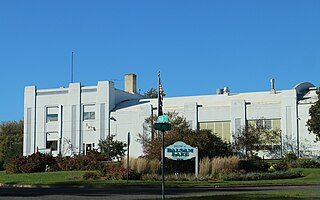The Wood River is a 47.7-mile-long (76.8 km) [1] tributary of the St. Croix River in western Burnett County, Wisconsin, United States. [2] It follows a meandering course in a generally westward direction. Its banks are mostly low and marshy, though there are high sandbanks in places. Although it flows through a few communities, for most of its course it flows through relatively natural settings.

The St. Croix River is a tributary of the Mississippi River, approximately 169 miles (272 km) long, in the U.S. states of Wisconsin and Minnesota. The lower 125 miles (201 km) of the river form the border between Wisconsin and Minnesota. The river is a National Scenic Riverway under the protection of the National Park Service. A hydroelectric plant at St. Croix Falls supplies power to the Minneapolis–St. Paul metropolitan area.

Burnett County is a county located in the U.S. state of Wisconsin. As of the 2010 census, the population was 15,457. Its county seat is Siren, with the majority of county governmental services located at the Burnett County Government Center. The county was created in 1856 and organized in 1865.
Its source can be traced to Wood Creek which drains wetlands near the village of Frederic, Wisconsin in Polk County. Wood Creek runs through the unincorporated settlement of Falun, located in the town of Daniels, Burnett County, and eventually empties into Little Wood Lake. Little Wood Lake is drained by the Little Wood River which flows a few miles westward to Big Wood Lake, located in the town of Wood River.

Frederic is a village in Polk County, Wisconsin, United States. The population was 1,137 at the 2010 census.

Polk County is a county in the U.S. state of Wisconsin. As of the 2010 census, the population was 44,205. Its county seat is Balsam Lake. The county was created in 1853.
The Wood River proper begins at the north end of Big Wood Lake. It flows north several miles before it arcs back through the village of Grantsburg and on to the St. Croix River, several miles south of State Highway 70.

Grantsburg is a village in Burnett County in the U.S. state of Wisconsin. The population was 1,341 at the 2010 census. The village is located within the Town of Grantsburg. It was established by Canute Anderson.

State Trunk Highway 70 is a state highway in the U.S. state of Wisconsin. It runs east–west in northern Wisconsin from a shared terminus with WIS 101 at US 2 and US 141 near Florence to a connection with Minnesota State Highway 70 at the St. Croix River 5 miles (8.0 km) west of Grantsburg in Burnett County. It serves the communities of Grantsburg, Siren, Spooner, and the resort areas of Minocqua, Woodruff and Eagle River along its route. WIS 70 is the third most northern route to almost completely cross Wisconsin, stretching from Minnesota to within 4 miles (6.4 km) of the Michigan border.
In the Ojibwe language, this river was called Wiigobimizh-ziibi (Basswood River) because of the abundance of this tree, from which strips of softened inner bark were used as lashings or cording called wiigob. Because of the wetland complex through which the Wood River flows, the Ojibwe called the vicinity of the village of Grantsburg Gichi-Mashkiigiminakaaning (at the great place full of low-bush cranberries).

Ojibwe, also known as Ojibwa, Ojibway or Otchipwe, is an indigenous language of North America of the Algonquian language family. The language is characterized by a series of dialects that have local names and frequently local writing systems. There is no single dialect that is considered the most prestigious or most prominent, and no standard writing system that covers all dialects.

Cranberries are a group of evergreen dwarf shrubs or trailing vines in the subgenus Oxycoccus of the genus Vaccinium. In Britain, cranberry may refer to the native species Vaccinium oxycoccos, while in North America, cranberry may refer to Vaccinium macrocarpon. Vaccinium oxycoccos is cultivated in central and northern Europe, while Vaccinium macrocarpon is cultivated throughout the northern United States, Canada and Chile. In some methods of classification, Oxycoccus is regarded as a genus in its own right. They can be found in acidic bogs throughout the cooler regions of the Northern Hemisphere.









